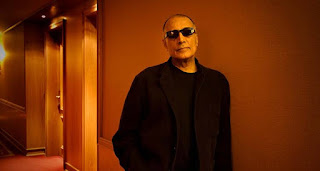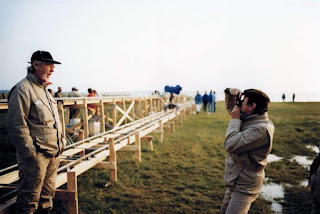“When Satyajit Ray passed on, I was very depressed. But after seeing Kiarostami’s films, I thanked God for giving us just the right person to take his place.”
One of the greatest filmmakers ever Akira Kurosawa had this to say about Abbas Kiarostami. With a career in filmmaking spanning 54 years, Kiarostami has made many films which were not only testament of his skills as a filmmaker but also his understanding of human condition as a humanitarian. If one takes a closer look at Kiarostami's filmography, one will find that most of his works question "the nature of mutual aid". What can we ask of others? Is there a form of request that we should not make and that we should not be outraged if it is refused? The grounds for refusal in his films are not self-serving, petty, they relate to the wounded humanity of people who cannot accept this.

Finally his films also questions with discretion and subtlety the censorship, dictatorship, unemployment, social conditions, the suffering and disarray of Iranians, the preponderant place of art in Iranian society, etc. With an astonishing economy of means and a remarkable minimalism Kiarostami has made us witnesses of a disarming and touching human adventures several times. Five such efforts which the writer believes to be the greatest are listed here.
5. The Wind Will Carry Us (1999)
The Wind Will Carry Us is probably Kiarostami's most twisty and devious film. We understand the ins and outs as we advance in his story, as we follow the main character during his stay in a village in Iranian Kurdistan. Evoking what it is about does not communicate the feeling of perplexity and disorientation that accompanies this wandering, where a contemptuous and jaded man seems little by little conquered by the beauty of a place, finding the capacity to notice signs of generosity and decency among its inhabitants.

This film also features probably the most unlikable protagonist of all Kiarostami films. Behzad is a disagreeable, disdainful and opportunistic man, quick to manipulate the villagers and indifferent to his technical team, glued to his cell phone, he travels back and forth between the surrounding fields and the heart of the village for his bitter exchanges, there is not an iota of sympathy for him in the audience. It reveals a concern about the risk of exploitation of less well off than oneself.
There is also a strong desire for change in Kiarostami here, even when he is showing himself to be the most accomplished director. What he probably does not want is to become jaded, too sure of his know-how, hence this film is also a temporary farewell to his way of constructing stories, where humans are settings and landscapes a character.
4. And Life Goes On (1992)
A large-scale earthquake devastated northern Iran in 1990 and left tens of thousands of people dead in the region of Koker, the same place where Kiarostami made, his first masterpiece Where is the friend's house?
So Kiarostami returns to film his second of his much-acclaimed Koker trilogy and made a film that retraces the initiatory journey of that place, its particular turmoil while also adding an important fictitious element: the presence of the director's son, who accompanies him on this journey.
Besides the obvious assurance of Kiarostami's staging, his status as a witness is what contributes to this authenticity. Far from being proud of this gaze informed by experience, however, he questions it. And life goes on also imposes what will become one of the recurring devices of his cinema: the car. This place which joins the private and the public, where one delivers oneself differently, by not staring at one's interlocutors, where the landscape and the environment are never disregarded.
Kiarostami also allows himself all the variables, the most abrupt breaks. Here again, he asserts the primacy of his gaze, of assumed decisions, against the fantasy of a neutral recording of reality. There is indeed a story, a "plot", but it is not everything. Life constantly exceeds the demands of storytelling.
3. Taste Of Cherry (1997)

Although I have placed this film at third position in the list, I'll have no qualms if one tells me that this is Kiarostami's ultimate masterpiece and his brightest achievement. Because The Taste of Cherry questions, like Kiarostami's work as a whole (which I mentioned earlier), the nature of mutual aid.
As is often the case, the subject is devilishly simple: Mr. Badii planned to kill himself by ingesting sleeping pills after dark; the day before, he was driving around the outskirts of Tehran in search of an accomplice, not to execute him, but to bury his remains in the early morning.
It was obviously badly received in Iran, on the grounds of dealing with suicide. Interestingly the recurring presence of the military underscores a bitter irony: it is regarded as despicable to attempt on one's own life, but worthy of praise to attack the lives of others. Distraught by an unusual request, a righteous desire to stop living, the soldier and the seminarian are lost, worried, attacked by a request that they would have preferred never to be made to them. It is all the more radical as Badii's motives are never explained.
Awakening in fiction, or posthumous paradise, cinema is here a form of salvation for director. Not so much the cinema he watches but the one he practices, as if the production was for the director a way of extracting himself from the absence of meaning, from the daily pain and inconvenience, suddenly sublimated, ordered.
The first of the three films that Abbas Kiarostami shoots in the village of Koker (which he refuses, despite the echoes, to qualify as a trilogy) opens, so to speak, with a closed door. It is that of a classroom where children await the arrival of their master, only to be bullied upon his arrival because of heckling. Where is the friend's house? is a story of reprimands, closures and misunderstandings, against which a wise, deserving boy will rise up in the name of a friendship, of a duty of mutual aid.
The film follows the route he takes in a few hours, on two occasions, between Koker and the hamlet, during this journey, trying for a boy of his age that hardly anyone seems to take into consideration, he discovers the injustice of the world as it is going, But he also learns that he is able to endure this, that solutions can be found and that sometimes disobedience does not only have negative consequences.
Already in this early film, the elements of Abbas Kiarostami cinema are present. The beauty of the landscape alternates with images of the sadness in the village and those visual allegories of the main character's dilemma. It's the look at the people who like the value of a movie like Where's the friend's house? that does not condemn, but reveals to what extent the characters are interwoven in a community and a system.
1. Close Up (1990)
Accepting sometimes to disguise reality in order to bring out a higher truth is somewhat of Kiarostami's leitmotif and trademark. In Close-Up , Kiarostami therefore invites us again - if need be - not to judge by appearances.
Close-Up, in addition to being a film of great nobility of feelings and, despite its raw cinema-verite appearance as close as possible to reality, also proves to be a breathtaking demonstration of the omnipotence of cinema as well as a fascinating meditation on artistic creation.
Beyond a brilliant demonstration of the ambiguity of human relationships, of a subtle confrontation between reality and fiction, Close Up is a humanist work. Abbas Kiarostami looks at the protagonists of this little tragedy without judging him and delegating this responsibility completely to the spectator, he has probably written the purest and most heartfelt love letter to cinema.
When I think of Abbas Kiarostami's films, three specific "images" come to mind: Hossain Sabzian, main character of 'Close Up' (1990) , who bursts into tears at the end of the film when his greatest wish is about to fail; an old woman who stops at the window of the car of the filmmaker traveling through an earthquake area in 'And Life Goes on' (1993) to simply tell him about her suffering and finally Mr Badii, who at the end of 'Taste of Cherry' (1997) who lies in the grave that he dug himself as night falls.
But for some inexplicable reason, the first image which comes to my mind when I think of Cinema is Sabzian riding a bike with Mohsen Makhmalbaf while holding flowers which he has bought as a token of atonement.
Thus personally I believe Close Up is not only the greatest Kiarostami film but the greatest film ever. A rare and perfect example of cinema interfering in reality which in turn inspires cinema.












Comments
Post a Comment